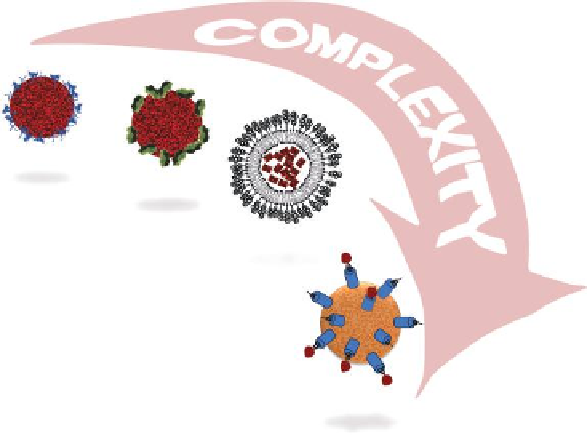Biomedical Engineering Reference
In-Depth Information
Emend®
*
Abraxane®
Doxil®
Drug
Surfactant
Protein
CALAA01
Phospholipid
PEG chain
Polymer excipient
Targeting ligand
(transferin as example in CALAA01)
FIGURE 6.1
Schematic examples of marketed and upcoming nanopharmaceuticals ranked
by increasing complexity (size dimensions not representative). *Emend: for the final medici-
nal product, microcrystalline cellulose is coated with the drug-surfactant nanoparticles.
(Agency, European Medicines (2004) EMED formulation [Scientific Discussion], 35.)
systems
, in which the drug is loaded into or onto a carrier of either one or several
excipient(s), that is, typically polymers or lipids. Nowadays there is a wide variety of
nanopharmaceutical formulations. Some consist of two or a few ingredients and are
simple in structure. Others are complex systems consisting of many different com-
ponents in often spatial arrangement (core-shell or multilayer structures). Figure 6.1
shows a few selected systems to illustrate this difference in complexity.
Reasons for the design of multicomponent systems are either the correction of a
nonsatisfying drug property or the opportunity to develop combined products with
multiple functions to improve the performance. The following list is only mentioning
frequent examples without the aim of being complete. A polymeric particle matrix
can enable a controlled release. The use of chemical cross-linkers or surfactants
is a measure to enhance colloidal stability. Hydrophilic, biocompatible polymers,
such as polyethylene glycol, are frequently used to coat nanoparticles for enhanced
blood circulation times. Small molecular weight excipients such as sugars or amino
acids are used as protection molecules for the formulation process of protein actives.
Specific ligands bound to the particle surface enhance cellular uptake into specific
target cells. Fluorophores or contrast agents are included to combine drug delivery
with imaging for diagnostic purposes in “theranostics.”
6.1.2 i
nto
the
h
uman
B
ody
, B
ut
s
afely
For nanopharmaceuticals, it is their intended use to enter the human body. A nano-
toxicological classification system (NCS) was proposed with the aim to group


Search WWH ::

Custom Search